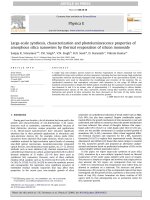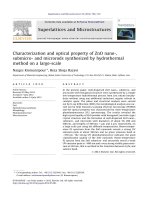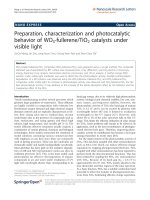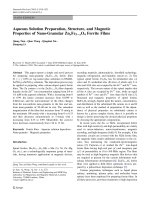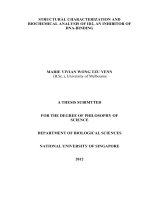Preparation, characterization and anti-corrosion properties of epoxy-organobentonite composite added ZnO submicrometer particles
Bạn đang xem bản rút gọn của tài liệu. Xem và tải ngay bản đầy đủ của tài liệu tại đây (386.23 KB, 13 trang )
Tạp chí Khoa học và Công nghệ 52 (1) (2014) 101-113
PREPARATION, CHARACTERIZATION AND ANTI-CORROSION
PROPERTIES OF EPOXY-ORGANOBENTONITE COMPOSITE
ADDED ZnO SUBMICROMETER PARTICLES
Bui Quoc Binh1, 2, *, Zhong Qingdong2, Zhou Qiongyu2
1
Faculty of Waterway Engineering, Vietnam Maritime University, Haiphong, Vietnam
2
Shanghai Key Laboratory of Modern Metallurgy and Material Processing,
Shanghai University, Shanghai, 200072, PR China
*
Email:
Received: 13 November 2013; Accepted for publication: 10 January 2014
ABSTRACT
In this paper, an epoxy-based composite coating containing various combinations of zinc
oxide submicrometer particles and organobentonite nanoparticles were prepared. Dispersion of
zinc oxide particles with organobentonite nanoparticles within the composites were evaluated
using XRD analyses. Hardness, adhesion, physical properties and corrosion resistance of
composites were studied. The results showed that simultaneous use of low-loading fillers have a
positive effect on the clay exfoliation behavior in resulting nanocomposites. Hardness, adhesion
of novel composites containing zinc oxide particle slightly increased compared with neat-epoxy
even though with epoxy-organobentonite composite. Corrosion performance of composites
increased with addition of zinc oxide and organobentonite particles, due to improving barrier
properties of the coating.
Keywords: anti-corrosion, epoxy-organobentonite composite coating, EIS, ZnO submicrometer
particles.
1. INTRODUCTION
Nowadays, steel has become an important part of our life due to its extensively applications
in automotive, household appliances, business machine and heavy construction such as marine
and chemical industries. Low-carbon steel is selected for construction because of its mechanical
properties and machine-ability at a low price [1]. It is known that when steel is exposed to a
natural atmosphere or marine environment, rust is formed. Although the rusting of steel is
usually termed as corrosion, the latter is a general term which is used to define the destructive
interaction of a material with its environment. Corrosion usually refers to metals and causes
enormous industrial losses with a depletion of our natural resources [2]. In this regard, polymeric
coatings can provide protection either by a barrier action from the layer or from active corrosion
inhibition supplied by pigments in the coating, which give protection to the underlying substrate
[3]. However, in practice, all polymeric coatings are permeable to corrosive species too such as
Bui Quoc Binh, Zhong Qingdong, Zhou Qiongyu
oxygen, water and ions to some extent [4 - 7]. Water molecules at the steel/coating interface may
reduce the coating adhesion, thus favouring corrosion of the metal underneath the film.
Attempts have been carried out to improve coating resistance against corrosive
environments. Some type of pigments i.e. chromate, phosphate, micro sized metallic or metal
oxides and organobentonite pigments have been utilized to improve corrosion resistance of the
organic coatings [8, 9]. It has been shown that organic/inorganic pigments can significantly
improve corrosion resistance of the organic coatings. Zhang et al. [10] showed that nanoTiO2 particle can significantly improve corrosion resistance of the epoxy coating. Dhoke and
Khanna [11, 12] revealed that nano sized ZnO particles can effectively improve corrosion
resistance of the coatings. It pointed out that nano-ZnO is a non-toxic particle. Therefore,
environmentally friendly coatings can be produced using these nanoparticles. Epoxy
nanocomposites containing different contents of nano-ZnO particles were prepared by B.
Ramezanzadech, M. M Attar, the nanocomposites were exposed to 3.5 wt% NaCl solution,
mechanical properties of the nanocomposites (before and after exposure to NaCl solution) were
studied. Results showed that corrosion resistance of the epoxy coating was significantly
improved using nanoparticles [13]. Nanoclay is also introduced into epoxy matrix and endowed
epoxy/clay composite significantly improved physical and chemical properties [14, 15]. In
previous studies [16 - 19], some types of epoxy-clay nanocomposite had prepared in order to
produce anti-corrosive epoxy coating. Anti-corrosive properties of nanocomposite were often
investigated using electrochemical impedance spectroscopy (EIS) methods. All of results
showed an improvement in the barrier and anti-corrosive characteristics of new composite
coating. But nano-pigments are a bit of high cost. Therefore, in the other way, some low-cost
filler are considered as pigments.
In this study, it has been aimed to investigate the effects of combine organobentonite
nanoparticles and ZnO sub-micrometer particles on the mechanical, physical properties and
corrosion resistance of epoxy based coating on Q235 low-carbon steel substrate.
2. MATERIALS AND EXPERIMENTAL
2.1 Materials
This research has used low-cost epoxy “GCC135” - a low viscosity liquid epoxy resin. The
GCC135 is a bisphenol A type epoxy resin, ethylene glycol diglycidyl ether. Appearance of
GCC135 epoxy resin: transparent liquid, no mechanical impurities; epoxy value (eq/100 g): 0.54
- 0.6; viscosity (mPas) : 700 - 1100; density (g/cm3): 1.13 - 1.17.
The W93 type has used as hardener - a low viscosity liquid hardener. The W93 is a
modified isophorone amine. Appearance of W93: colorless to pale yellow liquid; amine value
(KOH/g): 550 - 600 mg; viscosity (mPas): 10 - 100;
Epoxy resin and Hardener were purchased from G. C. Chem Co. Kunshan, China.
Ethanol, acetone (AR) and others reagent for preparation of artificial seawater (ASW) were
purchased from Sinopharm Chemical Reagent Co. Ltd, China.
TIXOGEL MP100 organobentonite was used as 1st filler which is a high organic bentonite.
The MP100 was purchased from Shunde District of Foshan City, Qinghong Trade Co. Ltd,
China. Performance of TIXOGEL MP100: Appearance: cream colored free flowing powder;
density: about 1.4 g/cm3; bulk density: 370 - 510 g/l; moisture content: ≤ 3 %; 90 microns sieve
residue: <15 %; full basic state: 1 - 5 µm, thickness of organobentonite plate about 1.4 nm.
102
Preparation, characterization and anti-corrosion properties of epoxy-organobentonite …
Submicron sized ZnO powder was purchased from Sinopharm Chemical Reagent Co. Ltd,
China with an average particle size of 120 - 260 nm.
Figure 1. Transmission electron microscope images of:
a) Tixogel MP100, b) submicron sized ZnO particles.
Q235 general structure steel (used as plain rebars in some cases) was purchased from
Angang Iron and Steel Group, Xinyang Iron & Steel Co., Ltd, China. Chemical composition of
Q235 steel in wt.% as C: 0.17, Si: 0.37, Mn: 0.08, P: 0.036, S: 0.039 and Fe: bal.
2.2. Preparation of epoxy-organobentonite nanocomposites added submicron size ZnO
nanoparticles
In the first stage, GCC135 epoxy resin was heated at 45 0C to reduce viscousity by heating
water bath, then, a desired quantity - 1.5 phr (phr - parts per hundred of total weight of epoxy
resin and hardener) of organobentonite MP100 was added to the resin and hand stirred until all
the fillers had been immersed. The mixture was stirred at 600 rpm for 15 min., 1200 rpm for
next 15 min., 2600 rpm for next 1 h and 300 rpm for 30 min. using a variable speed mechanical
stirrer fitted with a high shear impeller at heating condition. After that, the mixture had been
self-degassed at 45 °C for 6 h. The desired quantity (0.75, 1 and 1.25 phr - parts per hundred of
total epoxy resin and hardener) of ZnO submicron size articles was added to the mixture, the
mixture was stirred at 900 rpm for next 15 min., 2000 rpm for next 1 h and 300 rpm for 30 min.
After that, the mixture had been self-degassed at 45 °C for 6 h and degassed under vacuum in
vacuum oven for next 2 h. At last, W93 hardener was added. Prior to curing, the mixture was
cooled at ambient temperature (25 ± 2 0C). Curing was done in ambient condition at 24 h.
2.3. Electrodes preparation
A copper wire was electrically connected to one surface of each 10 mm × 10 mm × 0.5 mm
Q235 steel piece, and then this surface and all th��������������������������������������������������������������������������������������������������������������������������������������������������������������������������������������������������������������������������������������������������������������������������������������������������������������������������������������������������������������������������������������������������������������������������������������������������������������������������������������������������������������������������������������������������������������������������������������������������������������������������������������������������������������������������������������������������������������������������������������������������������������������������������������������������������������������������������������������������������������������������������������������������������������������������������������������������������������������������������������������������������������������������������������������������������������������������������������������������������������������������������������������������������������������������������������������������������������������������������������������������������������������������������������������������������������������������������������������������������������������������������������������������������������������������������������������������������������������������������������������������������������������������������������������������������������������������������������������������������������������������������������������������������������������������������������������������������������������������������������������������������������������������������������������������������������������������������������������������������������������������������������������������������������������������������������������������������������������������������������������������������������������������������������������������������������������������������������������������������������������������������������������������������������������������������������������������������������������������������������������������������������������������������������������������������������������������������������������������������������������������������������������������������������������������������������������������������������������������������������������������������������������������������������������������������������������������������������������������������������������������������������������������������������������������������������������������������������������������������������������������������������������������������������������������������������������������������������������������������������������������������������������������������������������������������������������������������������������������������������������������������������������������������������������������������������������������������������������������������������������������������������������������������������������������������������������������������������������������������������������������������������������������������������������������������������������������������������������������������������������������������������������������������������������������������������������������������������������������������������������������������������������������������������������������������������������������������������������������������������������������������������������������������������������������������������������������������������������������������������������������������������������������������������������������������������������������������������������������������������������������������������������������������������������������������������������������������������������������������������������������������������������������������������������������������������������������������������������������������������������������������������������������������������������������������������������������������������������������������������������������������������������������������������������������������������������������������������������������������������������������������������������������������������������������������������������������������������������������������������������������������������������������������������������������������������������������������������������������������������������������������������������������������������������������������������������������������������������������������������������������������������������������������������������������������������������������������������������������������������������������������������������������������������������������������������������������������������������������������������������������������������������������������������������������������������������������������������������������������������������������������������������������������������������������������������������������������������������������������������������������������������������������������������������������������������������������������������������������������������������������������������������������������������������������������������������������������������������������������������������������������������������������������������������������������������������������������������������������������������������������������������������������������������������������������������������������������������������������������������������������������������������������������������������������������������������������������������������������������������������������������������������������������������������������������������������������������������������������������������������������������������������������������������������������������������������������������������������������������������������������������������������������������������������������������������������������������������������������������������������������������������������������������������������������������������������������������������������������������������������������������������������������������������������������������������������������������������������������������������������������������������������������������������������������������������������������������������������������������������������������������������������������������������������������������������������������������������������������������������������������������������������������������������������������������������������������������������������������������������������������������������������������������������������������������������������������������������������������������������������������������������������������������������������������������������������������������������������������������������������������������������������������������������������������������������������������������������������������������������������������������������������������������������������������������������������������������������������������������������������������������������������������������������������������������������������������������������������������������������������������������������������������������������������������������������������������������������������������������������������������������������������������������������������������������������������������������������������������������������������������������������������������������������������������������������������������������������������������������������������������������������������������������������������������������������������������������������������������������������������������������������������������������������������������������������������������������������������������������������������������������������������������������������������������������������������������������������������������������������������������������������������������������������������������������������������������������������������������������������������������������������������������������������������������������������������������������������������������������������������������������������������������������% of the incident UV light
(Figure 4). At the same time more than 85 % of the incident UV light was absorbed by ECZa,
ECZb samples. Furthermore, only approximately 30 % visible light is transmitted through the
ECZ samples. It means that new ECZ composites have a good UV absorption properties. Hence,
those new materials have a potential application as UV stabilized materials for various outdoor
applications [21].
Figure 4. UV-VIS spectra of samples.
Figure 5. HV/0.2/5 results of of samples.
3.1.5. The microhardness (HV) and adhesion grade
HV results of 5 types samples are shown in figure 5. It pointed out that added
ZnO/organobentonite fillers increasing hardness of composites effectively.
107
Bui Quoc Binh, Zhong Qingdong, Zhou Qiongyu
Adhesion of coating films on steel substrates was also investigated. The results revealed
that the adhesion does not vary strongly with increase in filler concentration. PE sample was up
to 4B grade and others were also up to 5B grade of adhesion.
3.2. Effect of filler particles on the corrosion resistance of the coated Q235 steel
EIS plots for all samples are presented in the Bode plot format as a function of exposure
time. According to the literature, the impedance modulus at the low frequency (|Z| at 0.01 Hz) is
a useful parameter to characterize the corrosion protection of coatings. The open cuircuit
potential was obtained before making AC impedent test also. The electrochemical analysis of
one bare Q235 steel after 56 days of immersion in ASW was carried out for comparison.
a)
c)
b)
d)
Figure 6. Bode plots of: a) Bare Q235 steel, PE, EC after 56 days, b) ECZ samples after 14 days,
c) ECZ samples after 28 days and d) ECZ samples after 56 days of immersion in ASW.
Figure 6 provides the Bode plots data of bare and composite-coated steel in ASW solutions,
as a function of filler particles concentration and exposure duration. The values of OCP and
impedance |Z| at 10 mHz of all samples exposed to ASW at different immersion times are shawn
in Table 3. It should be cautioned that the OCP reading of the coated steel was contributed both
by the corrosion potential of the steel itself and by the electrical resistance of the coating layer.
As are shown in Fig. 6 and Table 3, because GCC135 is a low viscosity liquid epoxy resin,
60 µm thickness PE coating had poor protective effect. After 56 days of immersion, it has the |Z|
value at 10 mHz nearly 7 times of bare Q235 steel and the OCP of PE coating sample is linear
increment following immersion time. The incorporation of a small amount of organobentonite
(1.5 % by total weight of resin and hardener) into the pure epoxy, the EC composite was
obtained, EC coating’s corrosion resistance is more effective than PE coating, the |Z| value at 10
mHz is more stability in corrosive solution but still at low value.
Incorporating low-loading organobentonite nanoparticles and ZnO submicron size particles
108
Preparation, characterization and anti-corrosion properties of epoxy-organobentonite …
together into epoxy coatings, in the initial period of immersion (after 14 days), the ECZb coating
possessed the highest |Z| value at 10 mHz, followed by the ECZc and ECZa just had a lowest |Z|
value at 10 mHz. After 28 days of immersion, the value of |Z| at a low frequency of 10 mHz
gradually decreased, at the same time, OCP decreased, which indicated that corrosion had
occurred. Until the end of immersion process, the value of |Z| at a low frequency of 10 mHz was
still maintained at around 106 Ohm.cm2. Because the amount of ZnO submicron size particles
was not enough to improve barier properties of ECZa strongly, so the value of |Z| at a low
frequency of 10 mHz and OCP gradually decreased.
With highest amount of ZnO submicron size particles, the ECZc coating had the value of |Z|
at a low frequency of 10 mHz, which was below 106 Ohm.cm2 after 14 days of immersion, then
inceased slightly after 28 days until the end of immersion. It proved that in this case, some ZnO
submicron size particles were not well dispersed into epoxy resin and MP100 mixture, the
number of pore in ECZc coating was much more than ECZb coating, some corrosion products
sealed the pores of the coating. Therefore, with suitable loading of fillers, a ECZb coating
showed good protective effect.
Table 3. The values of OCP and impedance |Z| at 10 mHz of all samples exposed to ASW.
|Z| at 10 mHz (Ohm.cm2)
OCP (V/vs SCE)
Samples
14 days
28 days
56 days
14 days
28 days
56 days
Bare Q235
-
-
-0.711
-
-
1.554E+3
PE
-0.623
-0.657
-0.670
4.452E+3
5.078E+3
1.071E+4
EC
-0.623
-0.634
-0.649
4.425E+4
4.042E+4
4.121E+4
ECZa
-0.615
-0.609
-0.62
2.381E+5
1.555E+5
1.101E+5
ECZb
-0.434
-0.487
-0.542
1.313E+6
1.082E+6
1.006E+6
ECZc
-0.496
-0.538
-0.558
8.765E+5
9.329E+5
1.203E+6
According to the other studies [3, 10], from Tafel polarization curves, it can be observed
that the anticorrosion properties of different coatings were further revealed clearly and directly.
It can be seen from Fig. 7 and table 4, once again, that the ECZb coatings indicated the highest
corrosion potential (Ecorr = -0.631 V). Then, the pure epoxy coating showed the lowest
corrosion potential. However, the sequence of the corrosion current (Icorr) is just the opposite.
The corrosion current is an important factor to characterize the anticorrosion performance. The
pure epoxy coatings had the highest corrosion current. Then, the ECZc coating had the lowest
corrosion current.
109
Bui Quoc Binh, Zhong Qingdong, Zhou Qiongyu
Figure 7. Tafel polarization curve of all samples after 56 days immersion in ASW.
As were shown in Table 4, after 56 days of immersion, the filler particles reduced the
corrosion rate of composite coated Q235 steel by 2.3 times with pure epoxy, by 10 times with
organobentonite only, by 23 times with ECZa, by around 356 and 410 times with
organobentonite and ZnO submicron size particles together in ECZb and ECZc.
Table 4. Fitting values of Tafel plot of different coatings after 56 days immersion in ASW.
Fitting values of Tafel plot
Samples
Ecorr (V)
Icorr (A.cm-2)
CR (mm/year)
Bare Q235
-0.869
1.910E-5
2.218E-1
PE
-0.868
8.217E-6
9.543E-2
EC
-0.816
1.849E-6
2.147E-2
ECZa
-0.761
8.187E-7
9.500E-3
ECZb
-0.631
5.370E-8
6.236E-4
ECZc
-0.635
4.659E-8
5.410E-4
It pointed out that with suitable loading; the resistance values were much higher than those
of pure epoxy coating. Furthers more, this indicated effectiveness of ZnO particles for improving
barrier properties of coating layer.
a)
b)
c)
d)
e)
f)
Figure 8. Digital photograph of composite-coated Q235 steel exposed to ASW after 56 days:
a) bare Q235 steel, b) PE coating, c) EC coating, d) ECZa coating, e) ECZb coating, d) ECZc coating.
As were shown at Fig. 8, there is a thick rust layer on the surface bare steel samples, there
is a rust layer around perimeter of PE sample and there are some rust dots on the surface of EC
110
Preparation, characterization and anti-corrosion properties of epoxy-organobentonite …
sample. But on the surface of the ECZ samples, there are some colored dots only. It means that
solution diffused into interaction layer between coating and steel but no rust yet. This suggests
that filler particles improved the quality of the cured epoxy coating, reduced the porosity of the
coating matrix, and zigzagged the diffusion path available by deleterious species, leading to
improved barrier performance of the epoxy coating. Besides that, filler particles improved the
adherence of the cured epoxy coating to the underlying substrate and altered the physiochemical
properties of the coating-steel interface.
4. CONCLUSION
Incorporating low-loading organobentonite nanoparticles and ZnO submicron size particles
together into low-cost organic coatings improves the both anti-corrosive properties and
mechanical properties of coatings. Based on those results, the best performance of coatings was
obtained at 1phr ZnO submicron size particles concentrations (ECZb sample). It is suggestion
for economical consideration. By using mechanical mixing method or general machine, this type
of coating can be applied for protection of rebar, general low-carbon steel structures in corrosive
environment such as seashore in-field. This processing procedure can be applied for other type
of epoxy resin.
REFERENCES
1.
Behzadnasab M., Mirabedini S. M., Kabiri K., Jamali S. - Corrosion performance of
epoxy coatings containing silane treated ZrO2 nanoparticles on mild steel in 3.5 % NaCl
solution, Corrosion Science 53 (2011) 89-98.
2.
Mathiazhagan A. and Rani Joseph. – Nanotechnology - A New Prospective in Organic
Coating – Review, International Journal of Chemical Engineering and Applications 2 (4)
(2011) 225-237.
3.
Popovic M. M., Grgur B. N., Miskovic-Stankovic V. B. - Corrosion studies on
electrochemically deposited PANI and PANI/epoxy coatings on mild steel in acid sulfate
solution, Progress in Organic Coating 52 (2005) 359–365.
Leidheiser H. Jr., - Corrosion of painted metals – A review, Corrosion 38 (1982) 374–383.
4.
5.
González-García Y., González S., Souto R. M., - Electrochemical and structural properties
of a polyurethane coating on steel substrates for corrosion protection, Corrosion Science
49 (2007) 3514–3526.
6.
Walter G.W., - A critical review of the protection of metals by paints, Corrosion Science
26 (1986) 27–38.
7.
Van Westing E. P. M., Ferrari G. M., de Wit J. H. W., - The determination of coating
performance with impedance measurements: I. Coating polymer properties, Corrosion
Science 34 (1993) 1511–1530.
8.
Naderi R., Attar M. M. - Electrochemical study of protective behavior of organic coating
pigmented with zinc aluminum polyphosphate as a modified zinc phosphate at different
pigment volume concentrations, Progress in Organic Coating 66 (2009) 314-320.
9.
Naderi R., Attar M. M. - The role of zinc aluminum phosphate anticorrosive pigment in
protective performance and cathodic disbondment of epoxy coating, Corrosion Science 52
(2010) 1291–1296.
111
Bui Quoc Binh, Zhong Qingdong, Zhou Qiongyu
10. Zhang X., Wang F., Du Yuanlong, - Effect of nano-sized titanium powder addition on
corrosion performance of epoxy coatings, Surface of Coating Technology 201 (2007)
7241–7245.
11. Dhoke S. K., Khanna A. S., Jai Mangal Sinha T., - Effect of nano-ZnO particles on the
corrosion behavior of alkyd-based waterborne coatings, Progress in Organic Coating
64 (2009) 371–382.
12. Dhoke S. K., Khanna A.S. - Effect of nano-Fe2O3 particles on the corrosion behavior of
alkyd based waterborne coatings, Corrosion Science 51 (2009) 6–20.
13. Ramezanzadeh B., Attar M. M. - Studying the corrosion resistance and hydrolytic
degradation of an epoxy coating containing ZnO nanoparticles, Materials Chemistry and
Physics 130 (2011) 1208-1219.
14. Alexandre M., Dubois P., - Polymer-layered silicate nanocomposites: preparation,
properties and uses of a new class of materials, Materials Science and Engineering, 28
(2000) 1-63.
15. Liu W., Hoa S. V., Pugh M. - Organoclay-modified high performance epoxy
nanocomposites, Composites Science and Technology 65 (2005) 307–316.
16. Bagherzadeh M. R., Mahdavi F. - Preparation of epoxy-clay nanocomposite and
investigation on its anti-corrosive behavior in epoxy coating, Progress in Organic Coating
60 (2007) 117–120.
17. To Thi Xuan Hang, Trinh Anh Truc, Truong Hoai Nam, Vu Ke Oanh, Jorcin JB., Pébère
N. - Corrosion protection of carbon steel by an epoxy resin containing organically
modified clay, Surface & Coatings Technology 201 (2007) 7408–7415.
18. Trinh Anh Truc, To Thi Xuan Hang, Vu Ke Oanh, Dantras E., Lacabanne C., Oquab D.,
Pébère N., - Incorporation of an indole-3 butyric acid modified clay in epoxy resin for
corrosion protection of carbon steel, Surface & Coatings Technology 202 (2008) 4945–
4951.
19. To Thi Xuan Hang, Trinh Anh Truc, Olivier MG., Vandermiers C., Guérit N., Pébère N. Corrosion protection mechanisms of carbon steel by an epoxy resin containing indole-3
butyric acid modified clay, Progress in Organic Coatings 69 (2010) 410–416.
20. Culkin F. - The major constituents of sea water, In Riley J.P. and G., (1965) 121-161.
21. Alojz A., Zorica C. O., Majda Z. - Sub micrometer and nano ZnO as filler in PMMA
materials, Materials and Technology 45 (2011) 269–274.
112
Preparation, characterization and anti-corrosion properties of epoxy-organobentonite …
TÓM TẮT
CHẾ TẠO, ĐẶC TÍNH VÀ TÍNH CHẤT CHỐNG ĂN MÒN CỦA COMPOSITE NỀN
EPOXY CHỨA BENTONITE HỮU CƠ, BỘT ZnO CÓ CỠ HẠT DƯỚI MICROMETER
Bùi Quốc Bình1, 2, *, Zhong Qingdong, Zhou Qiongyu2
1
2
Khoa Công trình thủy, Trường Đại học Hàng Hải, Hải Phòng, Việt Nam.
Phòng Thí nghiệm Trọng điểm về Luyện kim và Sản xuất vật liệu tiên tiến, Đại học Thượng Hải,
Thượng Hải, Trung Quốc
*
Email:
Bài báo này trình bày quá trình chế tạo lớp phủ composite nền epoxy được tăng cường
bằng bentonite hữu cơ và bột ZnO có cỡ hạt dưới micrometer với các hàm lượng khác nhau. Sử
dụng phương pháp nhiễu xạ tia X để đánh giá khả năng phân tán bentonite và hạt ZnO vào nền
epoxy. Nghiên cứu độ cứng, độ bám dính, tính chất vật lí cơ bản và khả năng chống ăn mòn của
vật liệu chế tạo được. Kết quả nghiên cứu cho thấy rằng với hàm lượng thấp, bentonite hữu cơ
phân tán tốt vào nền epoxy và tạo ra loại composite tách lớp. Khi tăng cường thêm thành phần
bột ZnO, độ cứng và độ bám dính của vật liệu chế tạo được tăng nhẹ so với epoxy và epoxy có
gia cường bentonite hữu cơ. Khả năng chống ăn mòn của màng phủ làm bằng vật liệu mới cũng
được gia tăng do khi tăng cường đồng thời bentonite hữu cơ và bột ZnO vào nền epoxy thì khả
năng cản thấm của vật liệu cũng được cải thiện.
Từ khoá: chống ăn mòn, sơn tổng hợp epoxy-organobentonite, EIS, hạt submicrometer ZnO.
113
